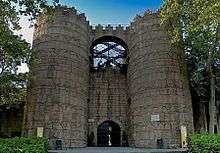Poble Espanyol
 Porta d'Àvila | |
| Established | 1929 |
|---|---|
| Location | Avda. Francesc Ferrer i Guardia, 13, Barcelona, Spain |
| Coordinates | 41°13′42″N 2°05′06″E / 41.2284°N 2.08492°E |
| Type | Architectural Museum |
| Director | Anton Vidal |
| Architect |
|
| Website |
www |
The Poble Espanyol (literally, Spanish town) is an architectural museum in Barcelona, Spain, just a few metres away from the Fountains of Montjuïc. The museum features exhibits on contemporary art, with streets, houses, parks, theater, school, restaurants and artisan workshops.
History
The museum was built for the 1929 Barcelona International Exposition as an exhibit of the architecture and culture of Spain. The idea was promoted by the Catalan architect Puig Cadafalch and the project was realized by architects Francesc Folguera and Ramon Reventós, art critic Miquel Utrillo and painter Xavier Nogués. The four professionals visited over 600,000 sites in Spain to collect the to bring together the main characteristics of the peoples of Spain.[1]
Description
Areas
The Poble Espanyol has 117 buildings representing fifteen autonomous communities of Spain - Andalucía, Aragón, Asturias, Cantabria, Castilla - La Mancha, Castilla y León, Cataluña, Comunidad Valenciana, Extremadura, Galicia, Islas Baleares, Madrid, Murcia, Navarra, País Vasco. The autonomous communities La Rioja and the Canary Islands are not represented. The first is not present because it wasn't a separate autonomous region when the museum was designed and built. The Canary Islands are not represented because the four designers could not visit them for economic reasons.
Monuments and buildings of the Poble Espanyol
The 117 buildings that are replicated include:
- Calle Cuna - Arcos de la Frontera Cádiz - Andalusia
- Torre de Utebo - Utebo - Aragón
- Cangues d'Onís - Cangas de Onís - Asturias
- Casa Barreda - Santillana del Mar - Cantabria
- El mirador - Sigüenza Guadalajara - Castilla - La Mancha
- Puerta de San Vicente - Ávila - Catilla y León
- Navalcarnero - Navalcarnero Madrid
- Casa de los Celdrán - Murcia
- Las Arcadas - Sangüesa - Navara
- Caserío Casa Arteche - Erandio Bizkaia - País Vasco
- Casa Son Berga - Palma de Mallorca - Islas Baleares
- Paço de los Fefinhas - Cambados Pontevedra - Galicia
- Palacio de los Golfines de Abajo - Cáceres - Extramadura
- La Jana - Castellón - Comunidad Valenciana
- Monasterio románico de Sant Miquel - Cataluña
Other exhibits and attractions
Although it was planned to be demolished when the International Exhibition was over, the museum was preserved because of its great success. The recreated village still contains the streets, squares and facades of the different areas of Spain. The village hosts many different events including gastronomic festivals, concerts in summer, Flamenco shows, private events such as weddings, and children's activities.
The Poble Espanyol exhibits more than 30 artisans who regularly work within the village making blown glass, leather, ceramics, jewelry, masks, baskets, and Spanish guitars. They create handmade items which are sold to the visitors.
The Poble Espanyol also contains rides, stores with gourmet products, and restaurants or bars with cuisine from the different regions of Spain.
Museum Fran Daurel
The museum Fran Daurel is situated within the Poble Espanyol. It is a private collection open to the public featuring over 295 works of contemporary Spanish artists including Pablo Picasso, Salvador Dalí, Joan Miró, Antoni Tàpies, Barceló, Josep Guinovart and Amat. The museum holds paintings, sculptures, tapestries, drawings and ceramics, and a sculpture garden, with 41 large sculptures. The works by Picasso include ceramics from the 1950s and 1960s, where he used both traditional techniqus and his own methods.
Theater
The Poble Espanyol has a theater that regularly organizes entertainment for children: theater, dance, music, clowns or puppets. The Barcelona School of Theatre also performs at this theater.
Activities for children
In addition to shows that take place every week in the theatre, Poble Espanyol has other activities for children: workshops (every Sunday morning), TOT Puppet Festival (March), living nativity scenes at Christmas, and family shows throughout the year (such as Carnivals, Santa Eulàlia, Fiesta Mayor, and Festival La Mercè)
References
- ↑ Documenting Spain: Artists, Exhibition Culture, and the Modern Nation, 1929Ð1939. Penn State Press. pp. 35–. ISBN 0-271-04720-8.
- Davey, J.; Zhen, C. (2015). Wimdu City Guides: No. 2 Barcelona: Barcelona Travel Guide. Wimdu City Guides. p. 10. Retrieved June 8, 2016.
- Bramblett, R. (2005). Europe For Dummies. Dummies Travel (in Spanish). Wiley. p. 523. ISBN 978-0-7645-8355-1. Retrieved June 8, 2016.
External links
| Wikimedia Commons has media related to Poble Espanyol. |
Coordinates: 41°22′08″N 2°08′49″E / 41.369°N 2.147°E